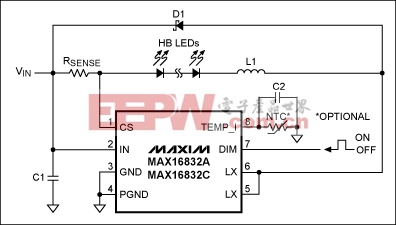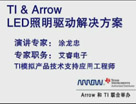Soft-start enhances LED driver
To emulate the natural soft start of an incandescent bulb, this circuit makes use of the thermal-foldback protection built into an LED-driver IC (MAX16832). It thereby avoids the annoying and almost instantaneous startup otherwise exhibited by LEDs.
One of the less obvious differences between incandescent light bulbs and LED-based lights is the speed at which they start up. An incandescent bulb requires some time to reach full brightness after you switch it on, and that delay gives the eye a comfortable interval for adjusting to the bright light. LED-based lights lack this property. Instead, their brightness goes from zero to 100% almost instantly. That property is welcome in a camera flash, but rather annoying for general lighting.
Fortunately, you can use the thermal-foldback protection built into an LED-driver IC (MAX16832) to emulate the natural soft start of an incandescent bulb. Figure 1 shows the typical application circuit for this IC.
Figure 1. This application circuit is typical for the MAX16832.
A negative-temperature-coefficient resistor (NTC) connected to pin 8 implements the thermal-foldback protection, by reducing output current when the temperature of the LED string exceeds a specified temperature. A constant-current source drives 25µA through this resistor, which is thermally attached to the LEDs. When the resulting NTC voltage drops below 2V (for which RNTC 80kΩ), an internal comparator alters (lowers) the bandgap reference voltage used by the driver for regulating the LED current. See the LED driver block diagram (Figure 2). The graph on the right in Figure 2 shows this action for a programmed LED current of 666mA. (The RSENSE value is 300mΩ.)
Figure 2. A simplified diagram (left) shows internal operation of the IC in Figure 1. The graph of LED output current versus VTEMP_I (right) assumes RSENSE = 300mΩ.













評論